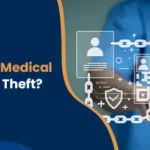What Is Medical Identity Theft? Risks, Impact, and Prevention

November 25, 2025
Medical identity theft isn’t just about stealing your personal data, it can compromise your medical record, impact your care, and derail insurance claims. The Federal Trade Commission (FTC) warns in its November 2024 guide that medical identity theft can leave victims with scrambled health records – and in some cases, these mistakes could keep them from getting the care they actually need. Beyond patient privacy, medical identity theft can jeopardize treatment quality and insurance eligibility—making it a serious threat to both patient safety and operational integrity.
In this article, we unfold what medical identity theft really is, explore common ways it can happen, and share practical steps for healthcare professionals to safeguard sensitive patient data and minimize potential threats.
What Is Medical Identity Theft and How Does It Impact Patients?
Medical identity theft is different from other scams because its consequences reach beyond stolen credit or drained bank accounts – it can harm a person’s health and finances at the same time.
What Is Medical Identity Theft?
Put simply, it happens when someone uses your information – such as your name, Social Security number, insurance details, or Medicare number – without your approval to get medical care, prescriptions, or submit fraudulent insurance claims.
The Dangers of Mixed Medical Records
Unlike credit card or financial fraud, medical identity theft can cause your health records to get mixed up with someone else’s. If a thief’s prescriptions, blood type, or allergies end up in your file, doctors might make decisions based on the wrong information. In an emergency, that could mean getting the wrong medication or treatment,a mistake that could be fatal.
The FTC warns that victims may be denied needed medical care later on or lose out on insurance coverage if their policy limits are used up or their eligibility is compromised.
Legal and Life Impacts
Medical identity theft can even affect your legal standing, insurance, and even job prospects. Some victims have lost access to health or life insurance or been turned down for employment due to false conditions listed in their records.. A 2016 Emory University Law Journal analysis highlighted the fact that just having your information exposed is considered an injury, even if you haven’t lost money. In short, the threat is broader than most realize – your health, finances, and reputation are all on the line.
If you’re ever notified about new medical bills or see confusing entries on your explanation of benefits, don’t wait – reach out to your provider or insurer right away to find out what happened. Early action gives you a better shot at clearing up errors before they spiral.
How Does Medical Identity Theft Happen in Healthcare?
Medical identity theft can sneak up in several ways, and each method leaves you vulnerable to different problems. By understanding how it occurs, healthcare professionals can spot the warning signs and help keep patient information safe.
How Information Gets Stolen
It often starts with lost or stolen information, like from a misplaced wallet, phishing emails, or data breaches at hospitals or clinics. Thieves can steal Social Security numbers, insurance cards, or billing info through cyberattacks, insider thefts, or even dumpster diving at medical offices.
A striking story from the University of Florida’s Risk Rx reported a clinic worker selling over a thousand patient records for just a few bucks per record. With those details, criminals can file bogus claims, get expensive drugs, or rack up bills that quickly drain a patient’s insurance.
Long-Term and Widespread Impact
Sometimes, criminals use someone’s details to get treatments at different hospitals. If the information blends across systems, victims end up with medical records that aren’t really theirs. Real-world examples include:
- A Pennsylvania man whose stolen identity paid for over $100,000 in healthcare.
- In Colorado, a small business owner’s company collapsed after medical errors in his records disrupted his insurance coverage and finances.
- .Most people don’t find out right away. Instead, they get odd bills, insurance claim denials, or calls from collectors. For some, their first clue comes from the insurance company flagging suspicious activity or a hospital inquiring about unknown treatments. The aftermath is often overwhelming – calls, paperwork, and confusion. That’s why understanding how this theft happens is so important. It puts the power back in your hands to help prevent it.
Prevention Tip
Putting a password or PIN on your medical and insurance files if your healthcare provider offers that option. adds another hurdle for would-be thieves trying to access your information.
How Do Medical Identity Theft Laws Affect Providers and Patients?
The impact of medical identity theft doesn’t stop at financial losses; it also puts patient care, insurance access, and job opportunities at risk. Both patients and healthcare providers face legal and clinical consequences when medical records are compromised.
Legal Recognition and Clinical Risk
Court cases, like those discussed in the Emory University Law Journal, show the law now recognizes medical identity theft as a distinct and serious harm. Victims often face more than just bills,they can receive improper or even dangerous medical care if their records are contaminated with false info from another person.
Healthcare workers use medical records to make quick decisions in emergencies. But if allergies, medications, or other vital details are wrong, patients may get treatments that aren’t meant for them. These risks go far beyond financial injury, they directly threaten patient safety.
.
Long-Term Fallout for Victims
This type of theft can also block access to insurance or hike up premiums. Some jobs require health checks, so a fake medical history could get someone turned down for employment. For providers, dealing with these issues means extra administrative work, and sometimes legal headaches if a patient is harmed because of inaccurate records.
Emotionally, the ordeal can take a heavy toll. Restoring records, disputing charges, and battling for claims may stretch out for months or even years, with errors lingering after things seem “resolved.” That’s why protecting medical identities isn’t just best practice – it’s essential for both the patient and provider.
If you’re a patient, ask for a copy of your medical records every once in a while. It’s your legal right, and doing so makes it easier to catch bogus entries or errors early on, before they affect your care or coverage.
Read More: HIPAA Pharmacy Compliance
How Can Healthcare Professionals Help Prevent Medical Identity Theft?
Healthcare providers have a big job when it comes to stopping medical identity theft, but they also have strong tools to protect patient data. A layered defense that combines technology, physical security, and staff awareness is the best safeguard.
Technical Defenses
According to the University of Florida’s Risk Rx, security starts with technology. Key steps include:
- Encrypting sensitive data to make stolen files unusable.
- Using secure networks and regularly updated firewalls.
- Requiring multi-factor authentication for system access.
- Implementing role-based access controls so only the right staff members see specific patient information.
Physical and Administrative Safeguards
Technology alone isn’t enough. Providers should also secure records through physical controls, lock file rooms, secure paper charts, and dispose of documents properly (shredding or certified destruction).
Administrative strategies matter, too. Ongoing staff training teaches everyone to spot phishing scams and follow strict ID check rules. Hospitals now require every patient to be identified at each visit, and staff learn to report anything suspicious right away.
Regular audit trails, tracking who accessed which records, help detect suspicious activity.
Routine risk assessments highlight weak spots before criminals can find them. Many organizations now join networks that alert them to unusual patterns of insurance use, too.
A Team Effort
A successful defense requires a culture of vigilance across the entire organization. From the front desk to IT, everyone plays a part in protecting data. Keeping prevention top of mind pays off – recent incidents of insider theft show why every safeguard is critical.
Running unannounced security checks (such as attempting to log into a patient portal or auditing older files for errors) helps identify and correct vulnerabilities early.
Even small lapses, like propping open a file room door, can create big risks.
What Should Individuals Do If Medical Identity Theft Happens?
Staying safe from medical identity theft takes some everyday habits, but acting quickly if something’s wrong can make all the difference.
Everyday Security Habits
Make a habit of checking your medical and insurance paperwork often. If you see a charge you don’t recognize, don’t brush it off, even minor mistakes deserve a closer look. Always keep your insurance card and Medicare number private, and avoid sharing details unless you’re sure it’s a trusted provider.
Ask your healthcare office how they protect your files. Make a habit of storing paperwork in a safe spot at home and shredding any medical documents you don’t need.
Spotting Trouble and Taking Action
Medical identity theft often leaves behind warning signs. Stay alert for warning signs, like getting bills for services you didn’t receive, calls from debt collectors, denied claims, or odd notices from the Internal Revenue Service.
If you suspect a problem, get in touch with your insurance company and the provider right away to correct mistakes. File a report with the FTC and ask them to fix any errors in your medical chart. Add credit freezes or fraud alerts for added protection and to stop further misuse of your identity.
Staying informed helps you stay safe. Watch out for phishing emails that look like they’re from your health plan – never click suspicious links. The more you know, the better you can avoid bigger problems down the road.
Don’t forget to create strong, unique passwords for online patient portals or apps that store your health data. It sounds basic, but even a slight tweak in password habits makes it much tougher for thieves to break in.
Conclusion
Medical identity theft creates major headaches for patients and healthcare providers alike. It can threaten your health, drain your finances, and even your career options.
Protection takes more than just locking up files. It takes watchful eyes, regular checks, and a commitment from everyone in the healthcare system to keep information safe.
Check medical statements, update your security practices, and deal with any suspicious charges quickly. Laws are adapting to account for the real harm medical identity theft can cause, so prevention, early action, and open communication are more important than ever. Stay alert and work together with your healthcare providers; these steps go a long way toward keeping your medical story accurate and protected.
FAQs
Q: What is medical identity theft, and how can it occur?
A: Medical identity theft happens when someone uses your name, Social Security number, or insurance details to get medical care or submit false claims. It can occur if your personal data is exposed or stolen.
Q: How can medical identity theft affect my health records?
A: Medical identity theft can mix false information into your health records. This may cause you to receive improper care or impact your ability to use insurance and receive correct treatment.
Q: What should I do if I suspect medical identity theft?
A: If you think your information was used without permission, review your medical records for errors and report issues right away. The Federal Trade Commission (FTC) gives steps for fixing errors and reclaiming your medical identity.
Q: How can healthcare organizations prevent medical identity theft?
A: Healthcare organizations can reduce medical identity theft by using regular security assessments, training staff, and having strong technical, physical, and administrative safeguards in place to protect patient information.





